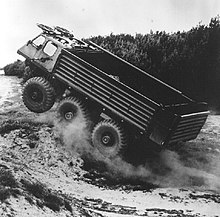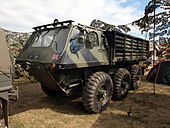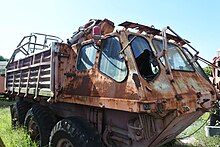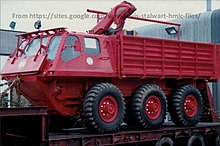|
Alvis Stalwart
The Stalwart, formally classified by the British Army as Truck, High Mobility Load Carrier (HMLC), 5 Ton, 6 x 6, Alvis Stalwart and informally known by servicemen as the Stolly, and by former RCT as the Stally,[1] is a highly mobile amphibious military truck. Built by Alvis Cars between 1960 and 1971, these vehicles served with the British Army from 1963 until 1993.[2][3] HistoryAlvis had great success with the FV603 Saracen armoured personnel carrier, being produced from 1952. The Saracen had permanent 6 wheel drive, and independent parallel wishbone links and torsion bar suspension on each wheel station. Alvis then used the same suspension and drive methods to develop the FV601 Saladin armoured car, and the Salamander airfield crash tender.[4] Following the success of those vehicles, Alvis then decided to start a private venture of an off-road truck, capable of carrying 5 tons and being highly mobile. Using the hull and cab of the Salamander, Alvis created the 'Camion' for the military and civilian market. The military, having conducted fording trials with the Saracen, asked if Camion would float. Camion is commonly known by its chassis number of PV 1 (Project Vehicle 1), and as "The Beast" by staff at Alvis. While the military carried out fording trials at Instow, Alvis went away and developed PV 2. PV 2 was put through a number of trials and tests both in the UK and Sweden, and received various facelifts to the cab roof and body sides along the way. The final version of PV 2 has twin hatches and a Hiab crane, compared to the original having full-length sideboards and a sliding roof hatch. PV 2 was named Stalwart. The Stalwart was adopted and entered service with the British Army in 1964 as a general transport truck in preference to the FV431, the load carrier variant of the FV430 series. The high mobility and amphibious capabilities were considered ideal for resupplying units in the field, particularly those of the British Army of the Rhine. Design The Stalwart is a frameless vehicle with an all welded waterproof hull - the hull forms a punt chassis. The engine is situated under the load deck in the rear of the hull and the gearbox with transfer box and differential forward of this. The load deck is open-topped with large drop-down panels on either side and rear. Waterproof seals ensure that these will not leak when in the water. The cab has the driver's position in the centre, and a seat for a passenger on the left side of the cab or either side on some models. The cab can only be entered through roof hatches. The dropping side windows are emergency escape hatches. The Stalwart can carry 5 tonnes of stores. Early press releases in Commercial Motor suggests it could tow 10 tonnes.[5][better source needed] But trial reports by MEXE showed it could easily handle 7.5 ton.[6][better source needed] In the water it can be driven at about 6 knots by vectored thrust water-jet propulsion units. The drive system, which includes the all-wheel drive, multiple gearboxes, and the water propulsion units, is complex and needed a lot of maintenance. When the amphibious qualities became unnecessary, it was common for the water jets to be removed to reduce weight and maintenance. The Stalwart's over-terrain capabilities come from the fact that the six-wheel-drive system lacks differentials, using simple bevel gears to transmit drive. A centre-mounted no-spin differential allows a certain amount of slip between the two sets of wheels on each side of the vehicle on hard surfaces, but there is no allowance for rotational speed differences between front and rear. The centre no-spin unit allows the wheels on either side of the vehicle with most grip to drive when off-road. This has the effect of making the vehicle appear to crab (move from side to side) when negotiating muddy conditions, thus making the Stalwart a true six-wheel-drive vehicle, with three wheels locked together and turning at the same speed. However, this system causes "wind up" in the transmission (inter-component stress) as all the wheels are forced to rotate at the same speed, which during cornering is impossible.[7] This led to rapid wear and breakage of the tracta joints within the drive train if the vehicle was used on firm surfaces, such as tarmac or concrete; in off-road conditions, the natural 'slip' of a loose surface, such as mud or gravel, reduced wind up. This problem is of special concern for modern-day Stalwart owners – to get a vehicle to a show requires moving it by low-loader or driving it on the road, risking damage to the transmission. Alternatively, the front and rear driveshafts can be removed, eliminating wind-up at the expense of off-road capability. During military use, the problem of transmission wind-up was solved by laying out railway sleepers (railroad ties) in a grid on flat ground and driving over them on long road moves; this allowed the transmission to unwind.[8] On more than one occasion, servicemen drove Stalwarts into car parks and used the kerbstones separating parking bays for the same purpose. Another problem with the transmission was that the vehicle was designed to be driven loaded. Driving the vehicle unloaded caused increased wear on the drivelines to the wheels as a result of the increased angle of mesh of the joints. See User manual and Crew reference card.[9][better source needed] Specifications
Variants Project vehiclesAll Prototypes for Stalwart were known as Private Venture (PV), and had the chassis number prefix PV. There were 15 PVs, with their destinations shown on Alvis letter of sales numbers.[12][better source needed]
The Camion was a one off project vehicle that inspired the Stalwart; it was chassis number PV1. It consisted of an Alvis Salamander hull and cab, with the radiator still located in front of the rear mounted engine.[13] 
PV 2, or Project Vehicle 2 took note of the MOD fording trials at Instow - and noted the roof hatch being used to access the cab. The first version of PV 2 had a sliding hatch, and full-length single-skin sideboards. The exhaust was also at the back of the cab.[14] Numerous obvious modifications were made to PV 2, with the last one being the installation of a Hiab crane. A very early version of PV2 is filmed by Pathe News in Devon. Note the exhaust pipe is still at the back of the cab, and the fuel cap is low on the left side of the cab – below the waterline. YouTube - PV2 showing it paces in Devon during 1961 A Pathé News film from 1962 of PV2 in the original configuration, with the full-length single-skin side boards. Note the troops' uniforms. - YouTube - Alvis Stalwart 1962 PV 2 is seen with crane fitted in a film about the merger of Rover group and Alvis Youtube - combat Land Rover line up   Production vehicles 
All MK 1 had the chassis prefix STAL, and ran from STAL 16 to STALL 140.[15][better source needed] Stalwart Mk 1 load carrier. This had a driver's and passenger's seat. The Mk 1 was used for troop movement in Aden, but the Stalwart was more regularly used for carrying packed fuel, over 300 Jerry cans, or ammunition as alternatives to the five tonnes of cargo in the UK and Germany. The majority of the Mk 1 models did not have winches fitted. Sweden mounted hydraulic winches onto the front of their MK 1 Stalwarts, known as Amfibiebil 101B. Sweden also mounted FOCO 4000 ZXX cranes on some of their vehicles, which are mounted to the left side of the cargo bay.   
All MK2 had the chassis number STAL 11/, and ran from STALL 11/1 to STAL 11/956.[16][better source needed] Stalwart Mk 2 load carrier. This had a driver's and passenger's seat, although a third seat could be fitted to the right of the driver as a field modification. All Mk 2 have an internal hydraulic winch, which only operates through the front and is mounted below the driver. The winch type is a Morris multi-layer drum, driven by a P.T.O. mounted hydraulic pump. The winch pull is 5400;kg. The MK 2 was known as Amfibiebil 101C in Sweden, and again some were fitted with the FOCO 4000 ZXX cranes.  Whilst the Stalwart could be used for troop movement, it was more regularly used for carrying Packed fuel (over 300 Jerry cans), ammunition, or the Gloster SARO UBRE Unit Bulk Refuelling Equipment pack as alternatives to the five tonnes of cargo. The jet drive units in all the Mk 2 variants were much more efficient, giving a claimed 9 knots. The most obvious visible difference between Mk 1 and Mk 2 variants is that the lower edges of the cab windows were now angled downwards rather than horizontal. This was to improve visibility at close range, particularly when being marshalled by a banksman standing nearby. A total of 956 Mk 2 FV622, FV623 and FV624 Stalwarts were produced, of which the British Army purchased 932, with 24 sold to other countries.[17][18] 
Stalwart Mk 2 limber. An artillery ammunition supply vehicle for the Abbot self-propelled gun. There was an extra seat in the cab for the crane operator plus four rear-mounted seats for a seven-man crew. An Atlas 3001/66 hydraulic crane capable of lifting three tons was added to the cargo area to lift palletised loads of ammunition. The rear crew folding seats were separated from the main cargo area by a wooden divider, and protected from inclement weather by two folding PVC hoods on metal hoops. When swimming on deep water when fording operations are expected, i.e. the vehicle will be subjected to full floatation, it is important that the maximum load be restricted to 3 tons 10 cwt. (3556 kg). A total of 269 Mk 2 Stalwart limbers were produced.[19]
Stalwart Mk 2 REME fitters' vehicle, based on the Mk 2 Stalwart. Two extra rear-mounted seats were added to the main cargo area for a four-man crew. An Atlas 3001 hydraulic crane capable of lifting three tons was added to the cargo area. This differed from that of the FV623 variant by having hydraulic anti-creep check valves fitted.[20] This modified crane was more stable (and safer) for lifting and holding engine, transmission, and other heavy equipment whilst manoeuvring them into position. When swimming on deep water when fording operations are expected, i.e. the vehicle will be subjected to full floatation, it is important that the maximum load be restricted to 3 tons 10 cwt. (3556 kg). A total of 60 Mk 2 Stalwart fitters' vehicles were produced.[21]
07ER57 (Chassis STAL 11/002, known to have been to Thailand for trials on Operation Mudlark in 1966) became 09AH16. 07ER63 became 00AG79. Both served with RAF from January 1967 to March 1976, when they were disposed of, being the first MK 2s available for second-hand purchase. They were based at RAF Gan as Reef Rescue and manned by the RAF fire fighters.[22] 
Bangkok International Airport bought a 623 Limber version as a rescue vehicle, in case any aircraft should end up in the water surrounding the airport. The main difference between this and every other Stalwart is the factory-fitted water monitor, mounted on the roof of the cab. This is chassis number STAL 11 / 706, and currently resides at Jesada Technik Museum in Bangkok. MOD Merlin records suggest that 706 was made in the first part of 1969.[23]    OperatorsMilitary operatorsListed by Alvis sales figures [24][better source needed] 
Of the Swedish Amfibiebil 101C sold in 1985;
Civil operators
In popular culture
Scale models
See alsoNotes and references
Further reading
https://sites.google.com/view/alvis-stalwart-hmlc-files/hmlc-stalwart-files External linksWikimedia Commons has media related to Alvis Stalwart.
|
||||||||||||||||||||||||||||||||
